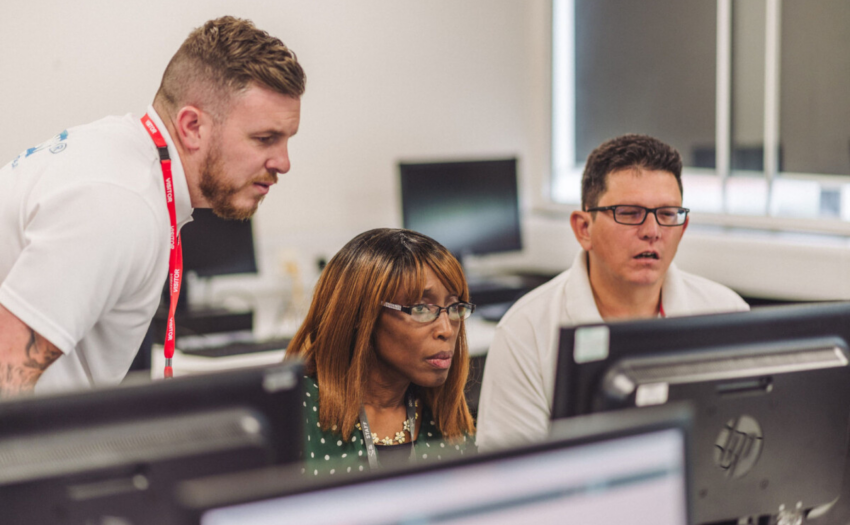Five Ways Visuals Help Learning
Now that we know from research how learning occurs, we can identify the specific ways in which visuals support five psychological processes. These same processes can be used to improve learning for students and, for educational professionals.

The sources
This advice post comes directly from a 500-page tome on cognitive psychology research called Graphics for Learning by Ruth Colvin Clark and Chopeta Lyons. Ruth Colvin Clark, in particular has worked with John Sweller and Richard Mayer, both luminaries belatedly discovered by the current generation of teachers.

1: Visuals support attention

When visuals are not merely decorative or entertaining, they can draw attention to essential elements in an instructional guide, avoiding the split or divided attention burden.
HOW2s achieve this by eliminating any extraneous detail like classroom furniture and even, characteristics of the students’ age, race or sex. Instead, essential procedural information comes to the fore by using clear step-by-step visuals, made evident by numbering and arrows.
2: Visuals help activate or build prior knowledge

By providing a visual overview of the process, visuals help trigger recognition and anticipate future content. This merging of past and future imagery helps connect to prior learning and assimilate future information.
HOW2s’ consistent use of procedural, step-by-step graphics help teachers recognise the format, and this aids them to connect to both their prior experiences of teaching and their knowledge of previously studied HOW2s.
Equally powerful is their ability to encourage the teacher to imagine walking through the teaching sequence. This visceral reading of the HOW2s adds an important personalised feeling to the learning process.
The visual element of the How2s offer a direct path into what a teaching technique IS about, its core pedagogic intent. The fact that the image is paired down and devoid of too much contextual information facilitates teachers to focus on the teaching and learning inherent in the activity and then adapt it to their context to meet the needs of their students (rather than having to‘work out’ /‘guess’ what to do). The universality of the images and the ideas they represent provides a focus for professional dialogue (visuals put everyone on the same page — not open to misinterpretation ) and for dialogue between teachers and students about what worked in the classroom.
These factors combine to make the complexity of teacher training and development quicker, easier and more effective.

Professor Kate Wall, University of Strathclyde
3: Visuals help minimise cognitive load

Cognitive load is when working memory is overloaded and cannot process incoming information. For this reason, photographs and videos can often be counterproductive. And why simple line drawings are superior in conveying precise information.
Additionally, some people are tempted to use what are termed decorative visuals, such as clip art, in an attempt to seduce students into taking an interest in the topic at hand. This, too, is counterproductive. It diverts attention away from the lesson’s aims and, consequently, confuses and overloads.
HOW2s are simple line drawings with all extraneous details cut out. As a result, viewers don’t have to work hard to know where to look and what to notice.
4: Visuals help build mental models

Well-designed visuals help the viewer construct new memories in their long-term storage, supporting a deeper understanding of the concepts and procedures involved. In addition, by locating all the elements on one page — viewed in one go — visuals present a coherent image that is more easily assimilated and stored away for future reference.
It’s one thing to be inspired by a guru on a training day and quite another to remember accurately the technique involved the following day in your classroom.
No such problems occur with HOW2s. Unified, coherent step-by-step visuals offer easy-to-assimilate packaged models. When teachers discuss teaching techniques, the visual reference to a HOW2 will ensure they are talking precisely about the same process.
5: Visuals help support the transfer of learning

The simpler the visual model, the easier it is to retain it in memory for transfer into classrooms. By focusing solely on those aspects directly related to the teaching technique in question, the visual model helps the viewer identify the key components necessary for deeper understanding.
HOW2s offer this level of simplicity and relevance and stimulate a visceral viewing of the technique. By visceral, I mean stimulating the imagination to feel as if one were there, in the diagram, so to speak, acting out the steps of the technique. Such imagining of the future stimulates physical responses that are re-ignited again when the teacher applies the HOW2 in the classroom.






